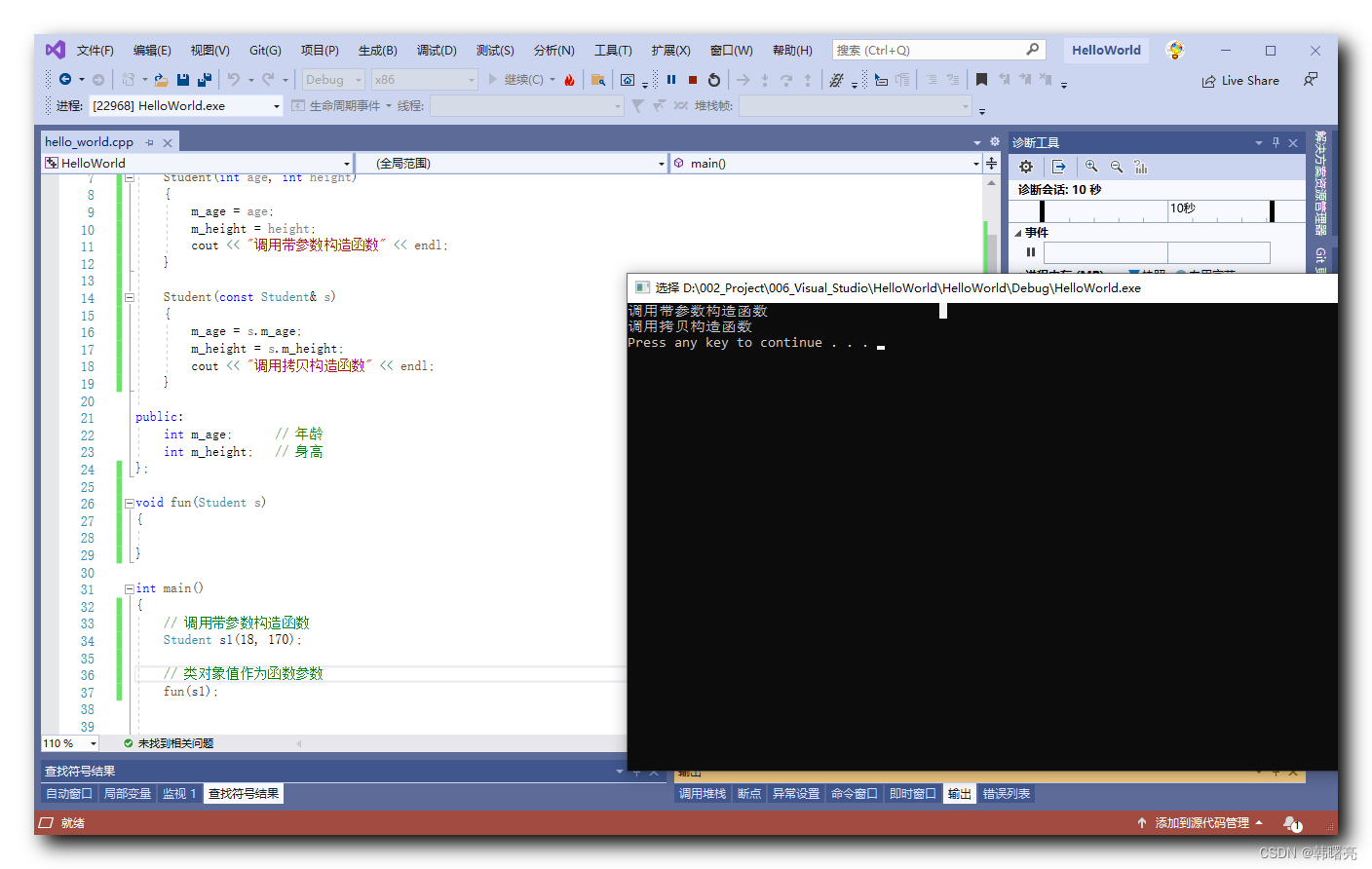-
【C++】拷贝构造函数调用时机 ② ( 对象值作为函数参数 | 对象值作为函数返回值 )
博客总结 :
" 拷贝构造函数 " 又称为 " 赋值构造函数 " , 该类型构造函数有 4 种调用时机 ;
- ① 使用一个对象初始化另外一个对象 : 使用 一个 类实例对象 初始化 另外一个 类实例对象 ;
// 使用一个对象初始化另外一个对象 // 直接手动 调用拷贝构造函数 Student s2 = Student(s1);- 1
- 2
- 3
- ② 将一个对象赋值给另外一个对象 : 将 一个 类实例对象 赋值给 另外一个 类实例对象 ;
// 将一个对象赋值给另外一个对象 // 自动调用拷贝构造函数 Student s2 = s1;- 1
- 2
- 3
- ③ 对象值作为函数参数 : 类的实例对象 以值的方式 传递给函数 , 不是以 指针 或 引用 的方式 ;
// 定义函数, 接收 Student 对象值作为参数 void fun(Student s) { }- 1
- 2
- 3
- 4
- ④ 对象值作为函数返回值 : 函数直接返回类的实例对象 值 , 不是返回 指针 或 引用 ;
// 定义函数, 返回 Student 对象值作为返回值 Student fun() { Student s1(18, 170); return s1; }- 1
- 2
- 3
- 4
- 5
- 6
一、拷贝构造函数概念
C++ 语言中的 拷贝构造函数 是 C++ 类中的 特殊构造函数 ,
其作用是 创建一个新的 类实例对象 , 作为现有实例对象的 拷贝后的副本 ;
拷贝构造函数 的 主要作用 是初始化新创建的对象 , 使其内容与原对象完全相同 ;
二、对象值作为函数参数
1、拷贝构造函数调用情况说明
类的实例对象 以值的方式 传递给函数 , 不是以 指针 或 引用 的方式 ;
这种情况 是 以 类的 实例对象 值作为参数 , 与 对象值 相对的是
- 对象指针
- 对象引用
定义函数 void fun(Student s) , 该函数 的 形参是 Student 类型对象 ,
// 定义函数, 接收 Student 对象值作为参数 void fun(Student s) { }- 1
- 2
- 3
- 4
- 5
如果调用该函数 , 需要拷贝实参 , 将 实参的副本值 , 也就是对象值 传递给函数形参 , 这个过程需要调用 Student 类的 拷贝构造函数 ;
该操作 全程 由 C++ 编译器完成 , 不需要 开发者 手动干预 ;
2、代码示例 - 对象值作为函数参数
代码示例 :
#include "iostream" using namespace std; class Student { public: Student(int age, int height) { m_age = age; m_height = height; cout << "调用带参数构造函数" << endl; } Student(const Student& s) { m_age = s.m_age; m_height = s.m_height; cout << "调用拷贝构造函数" << endl; } public: int m_age; // 年龄 int m_height; // 身高 }; // 定义函数, 接收 Student 对象值作为参数 void fun(Student s) { } int main() { // 调用带参数构造函数 Student s1(18, 170); // 类对象值作为函数参数 fun(s1); // 控制台暂停 , 按任意键继续向后执行 system("pause"); return 0; }- 1
- 2
- 3
- 4
- 5
- 6
- 7
- 8
- 9
- 10
- 11
- 12
- 13
- 14
- 15
- 16
- 17
- 18
- 19
- 20
- 21
- 22
- 23
- 24
- 25
- 26
- 27
- 28
- 29
- 30
- 31
- 32
- 33
- 34
- 35
- 36
- 37
- 38
- 39
- 40
- 41
- 42
- 43
- 44
执行结果 :
- 首先 , Student s1(18, 170) 调用带参数构造函数 , 创建 Student 类实例对象 ;
- 然后 , 将创建的实例对象 传递给 fun 函数 , 传递时由于传递的是 对象值 , 需要拷贝对象副本 , 拷贝副本时会自动调用 Student 类的 拷贝构造函数 ;
调用带参数构造函数 调用拷贝构造函数 Press any key to continue . . .- 1
- 2
- 3

三、对象值作为函数返回值
1、拷贝构造函数调用情况说明
函数直接返回类的实例对象 值 , 不是返回 指针 或 引用 ;
下面的代码 , 定义了函数 , 返回在函数内部创建的 Student 类实例对象 ;
// 定义函数, 返回 Student 对象值作为返回值 Student fun() { Student s1(18, 170); return s1; }- 1
- 2
- 3
- 4
- 5
- 6
由于 函数作用域结束后 , 其栈内存会被释放 , 在栈内存中的 Student 对象也会被销毁 , 因此 Student 类型的返回值需要返回一个副本 , 这个副本需要调用 拷贝构造函数 创建 ;
2、代码示例 - 对象值作为函数返回值
代码示例 :
#include "iostream" using namespace std; class Student { public: Student(int age, int height) { m_age = age; m_height = height; cout << "调用带参数构造函数" << endl; } Student(const Student& s) { m_age = s.m_age; m_height = s.m_height; cout << "调用拷贝构造函数" << endl; } public: int m_age; // 年龄 int m_height; // 身高 }; // 定义函数, 返回 Student 对象值作为返回值 Student fun() { Student s1(18, 170); return s1; } int main() { // 类对象值作为函数返回值 fun(); // 控制台暂停 , 按任意键继续向后执行 system("pause"); return 0; }- 1
- 2
- 3
- 4
- 5
- 6
- 7
- 8
- 9
- 10
- 11
- 12
- 13
- 14
- 15
- 16
- 17
- 18
- 19
- 20
- 21
- 22
- 23
- 24
- 25
- 26
- 27
- 28
- 29
- 30
- 31
- 32
- 33
- 34
- 35
- 36
- 37
- 38
- 39
- 40
- 41
- 42
- 43
执行结果 :

-
相关阅读:
vue3,axios获取的数据渲染不到页面上
HTML+CSS大作业 格林蛋糕(7个页面) 餐饮美食网页设计与实现
flink理论干货笔记(5)
30岁年薪28W,我还是没顶住压力跳槽了····
深入理解Linux网络笔记(三):内核和用户进程协作之epoll
一、Helm 3 简介
尚品汇_第6章_商品详情页
openssl升级
python中如何画语谱图
背景的样式
- 原文地址:https://blog.csdn.net/han1202012/article/details/132864537
